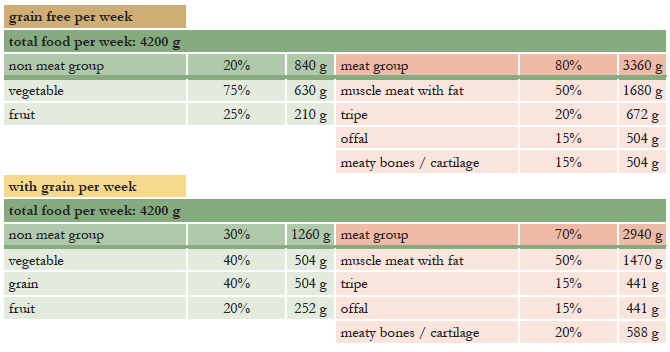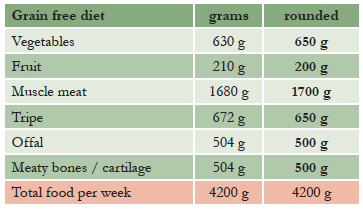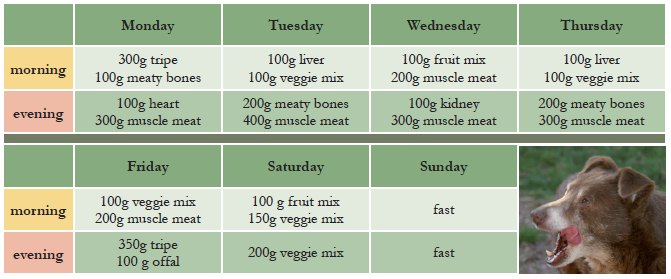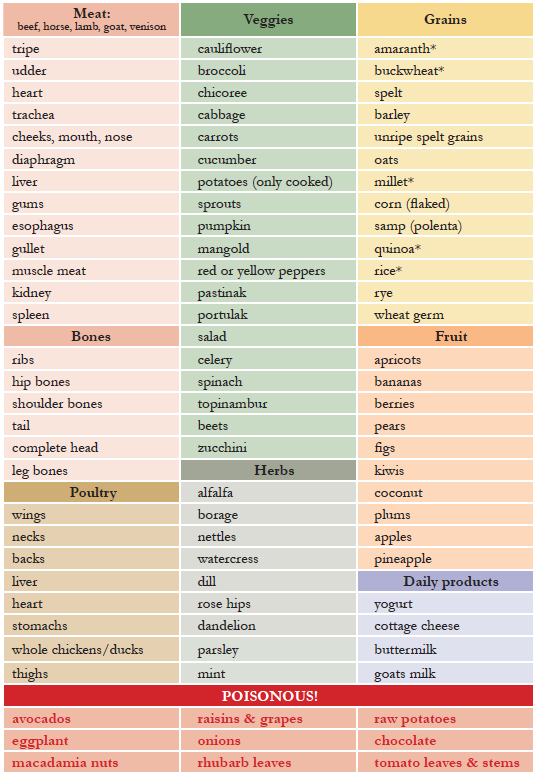When feeding a dog biologically appropriate raw food (BARF) you‘re basically trying to imitate nature. So, in the wild, a canine would eat whole animals or prey. Since most people cannot realistically feed whole prey animals, we are going to „build“ a prey animal instead.
What is prey made of ?
Meat, fat, bones, cartilage, sinew, organs, blood, intestines, intestinal contents, skin & fur. This is what we will try to feed, approximately in the proportions that prey would offer. Since we often cannot feed all components of a prey animal, we have to improvise some things. Also, it is not important to feed completely balanced meals every day, balance over a period of a month is fine. This means you can feed tripe only or meat only etc. for 1-2 days, or veggies only every other day, so it‘s not that much work.
When you start it‘s a good idea to make a plan.
First we figure out how much total food the dog needs per week. You may need to adjust this amount up or down, depending on whether your dog gains or loses weight. If he keeps his weight, then fine.
Generally, a young, active uncastrated male dog would need about 3 % of it‘s body weight per day in food. A moderately active, full grown dog might only need 2 % of it‘s body weight in food per day.
I‘m going to explain all this using kilograms and milligrams, so I hope you know the metric system.
1 kilogram is 1000 milligram.
1 pound (lb) = 453 gram
1 ounce = 28 gram
You can download an excellent conversion tool here: http://www.pawprint.net/vv/
It‘s called versaverter.
I‘ll use a 20 kg (44 lb) dog as an example and I‘ll use 3 % of his body weight assuming this dog is young and quite active. If your dog is not that active he may need less, if he‘s extremely active he may need more.
So, our sample dog would require about 600 g food per day. We will work out a weekly plan, so next we figure out how much food he needs per week. 600 g per day x 7 days = 4200 g food per week. Next, we divide the total amount of food into two basic food groups: meat and non-meat. Meat should be about 80 % of the total food, non-meat 20 %.
Meat: 4200 x 0.8 = 3360 g
Non-meat: 4200 x 0.2 = 840 g
Now we divide the non-meat group further into vegetables, fruits and grains (if you’re going to feed grains). The meat group gets devided into muscle meat, tripe, offal and meaty bones for the meat group. The percentages are in the table below. If you can’t get tripe or the dog is allergic to beef, then add 5 % to the offal and 10 % to the muscle meat.
You can feed grains, but if the dogs tends to have allergies, feed grain free. I‘ve included a table for diets with grain and grain free diets. At the end of article is a list of foods you can feed.

The muscle meat should contain a good percentage of fat (15 – 25 %), offal means organ meats like heart, liver, kidneys, spleen and sweetbreads (thymus glands), meaty bones should be bones with a good portion of meat and fat still attached. Do not refrain from feeding organ meats, especially liver, which contains many vitamins.
The importance of fat
The diet should contain 8-12 % fat in total – so of the 4200 grams of food about 420 g should be fats. This amount is including all fats; the fat in the meat, bones, offal, tripe plus any fats you may add to the diet such as fish or coconut oil. If the muscle meat contains 25 % fat you will not need to add fat except omega 3 fatty acids, but if it contains only 10 % fat, you should add enough animal fat to reach the total fat level needed in the diet. A lack of fat is one of the most common mistakes in homemade diets. Whendogs are getting almost no carbohydrates in their diets, as is the case here, they need fat for energy. While they can derive energy from protein, this is not ideal.
Vegetable oils are generally not good for dogs and cats with the exception of coconut oil, which has a unique combination of medium chain fatty acids that do not stress the pancreas when being digested.
The only oils I use for supplementation are:
Mixed fish or Krill oil (high quality) with Vit. E: 1 ml/5 kg bodyweight every other day
Cod liver oil: 1 tsp./15 kg bodyweight twice per week
Coconut oil: as extra fat or for deworming
Next you take the total amount per food group per week and round it up or down.
Like this:

Now the final step: you calculate how many meals you are going to feed per week. I recommend two meals per day, six days per week. One day per week should be a fasting day, preceded by a non meat day. This is in order to give the digestive system and the liver/kidneys a rest from meat and bone digestion.
You then divide the amounts of food for each food group by the number of meals you’re going to feed per week. You can decide to only feed veggies in a few meals, let‘s say five per week, so you don‘t necessarily have to feed each food group every meal or even every day. Remember, balance over time, not per meal.
So a weekly plan could look like this:

You can change the days so that it is convenient for you. For example change the fast day to Monday if Monday is a day where you have little time.
Preparation
Meat and bones are always fed raw! Cooked bones are dangerous!!!
If your dog is not used to bones, go easy on the bones at first. Grains need to be either soaked overnight in cold water or cooked.
Veggies and fruits should be chopped fine – best to use a food processor to make a kind of veggie mash. To this you can add some yogurt, cottage cheese or ground liver to make it taste good so that the dog eats it. The dairy products are assigned to the meat group, so be sure to subtract the amounts of dairy products from the meat group (muscle meat). Food should be room temperature or warmer – not cold!
Supplements
A good herbal supplement will enhance health and add phytonutrients and trace elements. Add some kelp to the diet to provide iodine and trace minerals.
Spirulina adds nutrients and stabilizes the intestinal flora.
Be sure to use only clean, high quality fish oil with an antioxidant like Vit. E
Pumpkin seeds contain zinc, fats and other nutrients and will get rid of tapeworms.
Coconut flakes add selenium and healthy antiparasitic fats.
Foods you can feed dogs
